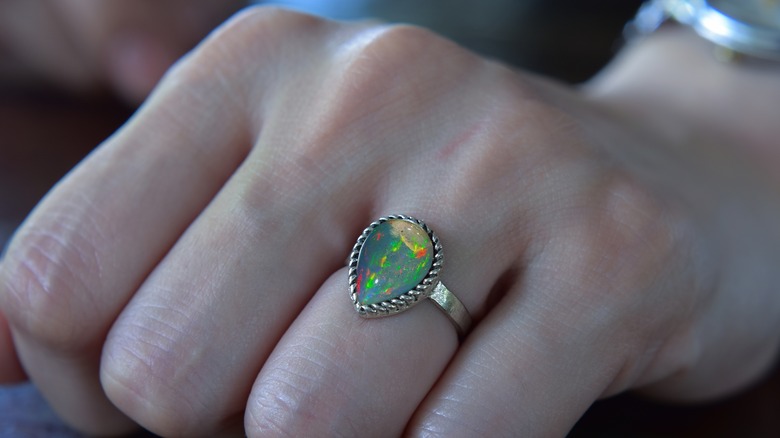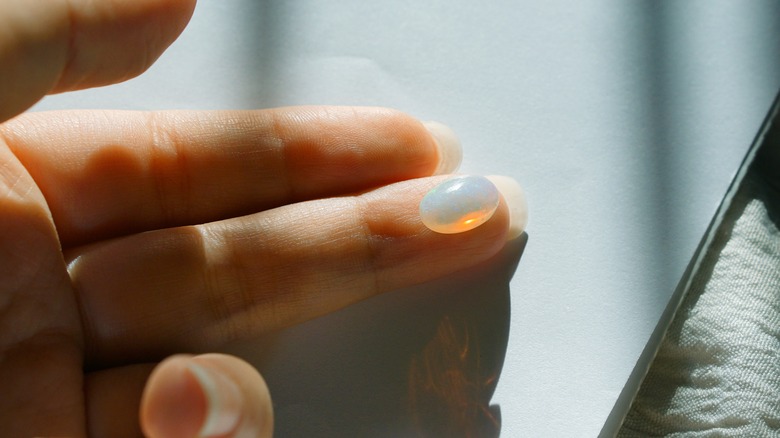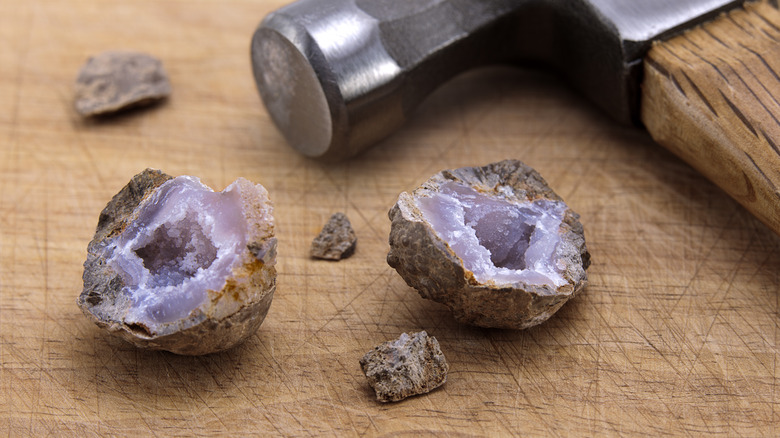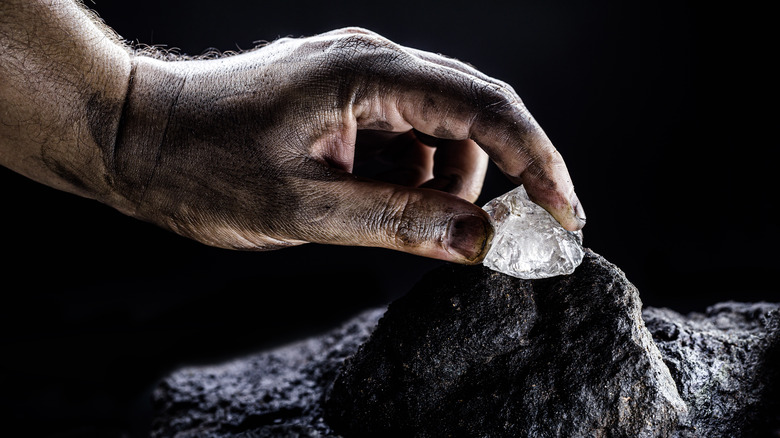Opals Are Stunning But Not The Best Engagement Ring Gem. Here's Why
In 2006, Leonardo DiCaprio and Djimon Hounsou brought the real-world issue of blood diamonds into the global consciousness with the action thriller "Blood Diamond." In it, we saw how people in Sierra Leone were subject to gang violence, amputations, abductions, and slavery, all in pursuit of mining diamonds for the worldwide market.
For centuries, women have worn their diamond engagement rings as a luxurious signal of their love with their partners. (In fact, the first recorded instance of a diamond presented for a betrothal was in 1477 between Mary of Burgundy and Archduke Maximilian of Austria, per The New York Times.) But having seen the suffering caused by the industry, were people willing to give up the precious stones for human rights?
It turns out, yes. The 21st century saw a shift from so-called blood diamonds to conflict-free gems and stones. Opals, the October birthstones that come in a range of glittering colors, became one popular alternative to diamond engagement rings. But are they a great choice for a ring you're going to wear every day for the rest of your married life? Will they last as long as a diamond? Are they as expensive as diamonds? We investigate.
Opals are very delicate
One big plus to having a diamond engagement ring is the stone's durability. Diamonds are so hard that they can cut glass. So for the modern woman, a diamond engagement ring will last throughout any occasion — a great training session at the gym, endless hours of working on your laptop, or even sawing a tree trunk in half. (What, did you think we were going to say "washing dishes?" What century is this?) Opals, however, are much less durable.
Opals are notoriously delicate, with something as small as a knock against a table able to chip them. They're like pearls that way, according to the International Gem Society. While they're not completely fragile, they're only about as strong as glass. Glass will stay in one piece in most circumstances, but if you've ever cracked your bifocals or dropped your wine glass, you can kind of imagine how durable an opal is on your finger. Taking an opal ring off every night is probably best, and not wearing it every day is even better.
The moisture content of opals can crack them open
Even if you avoid knocking it on the counter, another element could lead to the downfall of your beautiful opal ring: water. It may sound surprising, but if water can crack open rocks, it can do the same to opals. Think of how many times you wash your hands in a day (especially in this post-pandemic world). Are you always taking off your rings to do it?
With opals, however, much like our favorite horror movies, the call is coming from inside the house. These soft gemstones actually already contain up to 21% water, per the International Gem Society. It's this water content that can lead to opal damage if the gem is subject to a change in temperature, humidity, or pressure, per EraGem. The outlet reports that when an opal is taken from a place of dampness and high humidity, then exposed to hot direct sunlight or a drier climate, the water content in the stone can shift, creating an almost shattered look that's known as "crazing." Sometimes this appearance is temporary, sometimes permanent. So if you bought your opal in the Caribbean and you take it home to Canada in the middle of January, the freezing cold could damage the soft gemstone. Angara recommends not wearing your opal ring every day, but if you do, make sure you store it wrapped in a wet cloth to maintain moisture.
Some opals are unethically mined
On top of Leonardo DiCaprio and Djimon Hounsou, award-winning actor Jeffery Wright of "Casino Royale" fame is also highly invested in ending unethical mining. And you can be too, especially when trying to find the perfect opal engagement ring.
Even though "ethical opals" or "conflict-free opals" are mostly mined in Australia, which dominates around 95% of the opal market, there are still instances of unethically mined opals in other countries, per Nixin Jewelry. According to the outlet, the other 5% of mined opals come from Ethiopia, the U.S., Mexico, Brazil, Honduras, and the Czech Republic. Ethiopia has the largest opal mining industry after Australia, and it generates around $25 million annually. However, government oversight of mining operations in Ethiopia has led to an increase in smuggling — therefore, the opals mined there can no longer be certified as "conflict-free," as they might be tied to violence, child labor, extreme poverty, worker exploitation, and environmental harm.
Nixin Jewelry suggests asking dealers a lot of questions should you buy an opal from one of these countries, such as if the miners work in safe conditions or if they are receiving fair wages. Are the mines licensed? How is the local ecosystem affected by the mines? Does the government enforce regulations on the mines and ensure oversight? How were the opals imported into the U.S.? If your opal isn't tied to blood, you can certainly wear it with pride.
Opals are quite inexpensive
While opals have their problems, one big pro to choosing an unconventional stone for an engagement ring is the price. Societal norms dictate that a diamond engagement ring should cost approximately one month's salary, so if you're opting for an opal, the dollars might be on your side. According to Custom Made, white opals tend to be the most affordable, ranging between $150 to $400. So if you experience any of the issues listed above, like moisture damage or cracking, the price of fixing or replacing the stone won't break the bank.
Like diamonds, however, different kinds of opals range in value. The black opal, according to With Clarity, can cost anywhere from $50 to $10,000. Other opal varieties, like red or blue opals, can reach prices up to $500. Still, when we compare $500 with one month's salary, opals definitely come out ahead.
At the end of the day, if you're opting for an opal rather than a diamond engagement ring, make sure you've done your research. If you do end up getting an opal engagement ring, you could look like royalty. In fact, the late great Queen Elizabeth II was given the Andamooka Opal during her Australian visit in 1954, and was still seen wearing it in 2017, per The Sydney Morning Herald. Clearly, she was wrapping her opal in a moist towel every night!




